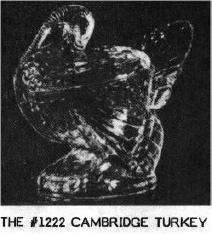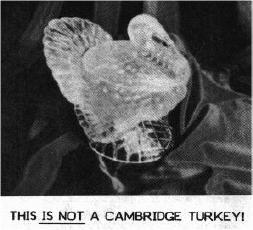Thanksgiving Turkey
by Phyllis D. Smith
Issue No. 175 - November 1987
With Thanksgiving right around the corner I thought perhaps one more article on the Cambridge Turkey might be appropriate. Several articles related to this bird have appeared in the Crystal Ball.

 Our Turkey Tales began way back in February 1974 (Issue #10) when
Charles Upton wrote the very first article, including the information
that a "look-alike" Turkey had been seen. This turkey is almost
identical to our Cambridge bird; with the most noticeable difference
between the two being the "waffle-like" detail on the base of the
non-Cambridge item. This is still the best way to tell the difference
between this look-alike turkey and the one made by Cambridge. THERE IS
NO WAFFLE DETAIL ON THE CAMBRIDGE BIRD!
Our Turkey Tales began way back in February 1974 (Issue #10) when
Charles Upton wrote the very first article, including the information
that a "look-alike" Turkey had been seen. This turkey is almost
identical to our Cambridge bird; with the most noticeable difference
between the two being the "waffle-like" detail on the base of the
non-Cambridge item. This is still the best way to tell the difference
between this look-alike turkey and the one made by Cambridge. THERE IS
NO WAFFLE DETAIL ON THE CAMBRIDGE BIRD!
In June 1976 (Issue #38) fellow members, Jack and Sue Rettig included in a short article the information that the Cambridge Turkey was pictured in the December 1930 issue of China, Glass and Lamps. This information gave us an introduction date, and with the reprinting of the 1930-34 Cambridge Catalog by NCC (also in June 1976) this date was further confirmed. While we have no exact records as to how long this bird was produced, it is known that this Turkey mold was added to the WWII scrap iron drive sometime in the very early 1940s, and consequently destroyed. So, at the very most, this Turkey was only in production for ten years.
The December 1976 issue of the Crystal Ball (issue #44) included yet another article on our feathered friend, written by Dave Rankin. Along with the "waffle base" information, he gave us the additional news that the L.E. Smith Company produced (and continues to do so) a turkey that is very frequently mistaken for the one made by Cambridge. He included the facts that the "circumference of the bases are 14" for Smith, 17" for Cambridge. Front to back with the lid off (breast to tip of feathers) is 7" for Smith, 9" for Cambridge. The width of the feathers at the widest point is 5½" for Smith and 7" for Cambridge." He also stated that "The opening for the lid on the Smith turkey is level where the Cambridge turkey slopes significantly downward toward the front. If you try to pick up these turkeys with one hand by reaching across the back behind the head, the smallest adult hand can get a firm grip on the Smith turkey, but the largest had cannot get a firm enough grip to pick up a valuable Cambridge turkey." During the 1978 Convention, speaker Dave Rankin conveyed this additional, easy way to tell a Cambridge Turkey from the L.E. Smith version. Simply remove its lid and stick your doubled-up fist into the cavity. A Cambridge turkey will accommodate two fists, with room to spare, according to the size of your fist. The L.E. Smith turkey has room for only one fist, regardless of its size.
In November 1979 (Issue #79) Doris Issacs wrote that Cambridge did indeed produce our turkey in crystal, as well as other colors. She included a photo of her crystal turkey with a Charleton type decoration. Turkeys have also been found in gold krystol, carmen, amber, royal blue, blue bell, willow and/or moonlight blue. Other colors are possible.
Best Wishes for a very Happy Thanksgiving!
